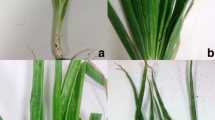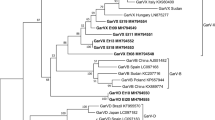Abstract
Among edible Allium plants (leek, onion, and garlic), leek yellow stripe (LYSV) and onion yellow dwarf virus (OYDV) are the most common viruses worldwide. While the presence of these two viruses in Turkey has previously been confirmed, only a few studies on their prevalence and genetic diversity have been performed. The aim of this study, conducted in the southern Marmara region of Turkey (SMR), was to identify the presence and genetic diversity of these viruses. Samples were collected from 494 plants exhibiting virus and virus-like symptoms. Samples were tested for the relevant viruses by double-antibody sandwich enzyme-linked immunosorbent assay and reverse transcription polymerase chain reaction (DAS-ELISA and RT-PCR, respectively). Tests revealed the presence of OYDV in 95 samples and LYSV in 52, whereas 33 samples were observed to have a combined infection. To examine the genetic diversity, 10 isolates from each virus were chosen from the infected samples. Using RT-PCR, the complete coat protein (CP) gene for LYSV and a partial sequence region of the nuclear inclusion b + CP gene for OYDV were amplified, cloned, and sequenced from the selected isolates. The sequence data were compared with the isolates in GenBank; it was determined that SMR LYSV and OYDV isolates show similarities over 77% with world isolates at the nucleotide and amino acid levels. Phylogenetic analyses showed that the LYSV and OYDV isolates had some diversity with isolates from different parts of the world, and the host had an important role in the phylogenetic relationships, particularly for LYSV.





Similar content being viewed by others
References
Abraham AD, Kidanemariam DB, Holton TA (2019) Molecular identification, incidence and phylogenetic analysis of seven viruses infecting garlic in Ethiopia. Eur J Plant Pathol 155:181–191
Adams MJ, Antoniw JF, Fauquet CM (2005) Molecular criteria for genus and species discrimination within the family Potyviridae. Arch Virol 150:459–479
Arya M, Baranwal VK, Ahlawat YS, Singh L (2006) RT-PCR Detection and molecular characterization of onion yellow dwarf virus associated with garlic and onion. Curr Sci 91:1230–1234
Baghalian K, Kim OK, Natzuaki KT (2010) Molecular variability and genetic structure of the population of onion yellow dwarf virus infecting garlic in Iran. Virus Genes 41:282–291
Bereda M, Elżbieta P, Kalinowska M, Stefan S (2015) Genetic diversity and evidence of recombination in the coat protein gene of onion yellow dwarf virus. Eur J Plant Pathol 142:377–387
Chen J, Adams MJ (2001) Molecular characterisation of a complex mixture of viruses in garlic with mosaic symptoms in China. Arch Virol 146:841–1853
Clark MF, Adams AN (1977) Characteristic of the microplate method of enzyme linked ımmune sorbent assay for the detection of plant viruses. J Gen Virol 34:475–483
Dovas CI, Hatziloucas E, Salomon R, Barg E, Shiboleth Y, Katis NI (2001) Incidence of viruses infecting Allium spp. in Greece. Eur J Plant Pathol 107:677–684
Dovas CI, Hatziloukas E, Salomon R, Barg E, Shiboleth Y, Katis NI (2002) Comparisons of methods for virus detection in Allium spp. J Phytopathol 149:11–12
Fajardo TVM, Nishijima M, Buso JA, Torres AC, Avila AC, Resende RO (2001) Garlic viral complex: identification of potyviruses and carlavirus in central Brazil. Fitopatol Bras 26:619–626
Fernández-Tabanera E, Fraile A, Lunello P, García-Arenal F, Ayllón MA (2018) First report of onion yellow dwarf virus in leek (Allium ampeloprasum var. porrum) in Spain. Plant Dis 102:256
Fidan H, Baloglu S (2009) First report of onion yellow dwarf virus and Leek yellow stripe virus in garlic in Turkey. Plant Dis 93:672
Gupta N, Islam S, Sharma SK, Baranwal VK (2017) Complete genome sequence of an isolate of leek yellow stripe virus from garlic in India. J Plant Pathol 99:793–797
Katis NI, Maliogka VI, Dovas CI (2012) Viruses of the genus Allium in the mediterranean region. Adv Virus Res 84:163–208
Korkmaz S, Cevik B (2009) Leek yellow stripe virus newly reported in Turkey. Plant Pathol 58:787
Kumar S, Stecher G, Tamura K (2016) MEGA7: molecular evolutionary genetics analysis version 7.0 for bigger datasets. Mol Biol Evol 33:1870–1874
Lee JB, Kim SM, Lee JS, Park JW, Choi HS, Lee JH, Lee KW, Lee SH (2005) Incidence and variation of the viruses in the northern ecotype garlic. J Virol Methods 124:55–56
Li QQ, Zhou SD, He XJ, Yu Y, Zhang YC, Wei XQ (2010) Phylogeny and biogeography of Allium (Amaryllidaceae: Allieae) based on nuclear ribosomal internal transcribed spacer and chloroplast rps16 sequences, focusing on the inclusion of species endemic to China. Ann Bot 106:709–733
Lot H, Chevelon V, Souche S, Dellecolle B (1998) Effects of onion yellow dwarf virus and leek yellow stripe virus on symptomatology and yield loss of three french garlic cultivars. Plant Dis 82:1381–1385
Muhire BM, Varsani A, Martin DP (2014) SDT: a virus classification tool based on pairwise sequence alignment and identity calculation. PLoS ONE 9:e108277
Rahman K, Lowe GM (2006) Garlic and cardiovascular disease: a critical review. Nutr J 136:736–740
Santosa AI, Ertunc F (2020) Identification, molecular detection and phylogenetic analysis of four viruses infecting Allium cepa in Ankara Province, Turkey. J Plant Dis Prot 127:561–569
Shahraeen N, Lesemann DE, Ghotbi T (2008) Survey for viruses infecting onion, garlic and leek crops in Iran. Bull OEPP 38:131–135
Snihur H, Shevchenko T, Sherevera K, Budzanivska I, Shevchenko O (2019) First report of onion yellow dwarf virus in Ukraine. J Plant Pathol 101:1283–1283
Taglienti A, Tiberini A, Manglli A, Rea R, Paoletti S, Taviani P, Tomassoli L (2018) Molecular identification of allexiviruses in a complex mixture of garlic viruses in Latium (central Italy). Eur J Plant Pathol 150:797–801
Takaki F, Sano T, Yamashita K, Fujita T, Ueda K, Kato T (2005) Complete nucleotide sequences of attenuated and severe isolates of leek yellow stripe virus from garlic in northern Japan: identification of three distinct virus types in garlic and leek world-wide. Arch Virol 150:1135–1149
Winiarczyk K, Solarska E, Sienkiewicz W (2014) Prevalence of infections with onion yellow dwarf virus, leek yellow stripe virus and garlic common latent virus in plants from the genus Allium. Acta Sci Pol Hortorum Cultus 13:123–133
Wylie SJ, Li H, Jones MG (2012) Phylogenetic analysis of allexiviruses identified on garlic from Australia. Australas Plant Dis Notes 7:23–27
Author information
Authors and Affiliations
Contributions
SK: designed the study. HTT and AK: collected the samples and performed the laboratory tests. AK and SK: performed the bioinformatic analyses. All authors interpreted of results, drafted manuscript preparation, and approved the final version of the manuscript.
Corresponding author
Ethics declarations
Conflict of interest
The authors declare that they have no known competing financial interests or personal relationships that could have appearedto influence the work reported in this paper.
Ethical approval
This article does not contain any studies with human participants or animals performed by any of the authors.
Informed consent
Informed consent was obtained from all individual participantsincluded in the study.
Supplementary Information
Below is the link to the electronic supplementary material.
Rights and permissions
About this article
Cite this article
Tuzlali, H.T., Karanfil, A. & Korkmaz, S. Occurrence of leek yellow stripe virus and onion yellow dwarf virus from edible Allium plants in the south Marmara region of Turkey. 3 Biotech 11, 516 (2021). https://doi.org/10.1007/s13205-021-03067-1
Received:
Accepted:
Published:
DOI: https://doi.org/10.1007/s13205-021-03067-1




